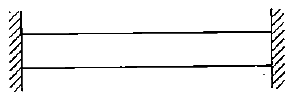A steel wire of corss sectional area 0.5mm2 is held between two rigid clamps so that it is just taut at 20∘C. Find the tension in the wire at 0∘C. Given that Young's Modulus of steel is Yst=2.1×1012 dynes/cm2 and coefficient of linear expansion of steel is αst=1.1×10−5.∘C−1
To find the tension in the steel wire at 0∘C, we will use the relationship between Young's modulus, stress, strain, and the coefficients of linear expansion. Here’s a step-by-step solution:
Step 1: Convert the area of cross-section
The area of cross-section is given as 0.5mm2. We need to convert this to cm2 because Young's modulus is given in dynes/cm².
0.5mm2=0.5×10−2cm2=0.00005cm2
Step 2: Identify the given values
- Young's modulus of steel, Yst=2.1×1012dynes/cm2
- Coefficient of linear expansion, αst=1.1×10−5∘C−1
- Change in temperature, ΔT=20−0=20∘C
Step 3: Calculate the change in length (ΔL)
The change in length due to a change in temperature can be expressed as:
ΔL=L⋅α⋅ΔT
However, since the original length L will cancel out later, we do not need its value explicitly.
Step 4: Use the formula for tension
The tension T in the wire can be expressed in terms of Young's modulus, area, coefficient of linear expansion, and change in temperature:
T=Y⋅A⋅α⋅ΔT
Step 5: Substitute the values
Now we substitute the known values into the equation:
T=(2.1×1012dynes/cm2)⋅(0.5×10−2cm2)⋅(1.1×10−5∘C−1)⋅(20∘C)
Step 6: Calculate the tension
Calculating step-by-step:
1. Calculate 0.5×20=10
2. Now, calculate 10⋅1.1×10−5=1.1×10−4
3. Finally, calculate 2.1×1012⋅1.1×10−4=2.31×108dynes
Thus, the tension in the wire at 0∘C is:
T=2.31×108dynes
Final Answer:
The tension in the wire at 0∘C is 2.31×108dynes.
---
The area of cross-section is given as 0.5mm2. We need to convert this to cm2 because Young's modulus is given in dynes/cm².
- Young's modulus of steel, Yst=2.1×1012dynes/cm2
- Coefficient of linear expansion, αst=1.1×10−5∘C−1
- Change in temperature, ΔT=20−0=20∘C
The change in length due to a change in temperature can be expressed as:
The tension T in the wire can be expressed in terms of Young's modulus, area, coefficient of linear expansion, and change in temperature:
Now we substitute the known values into the equation:
Calculating step-by-step:
2. Now, calculate 10⋅1.1×10−5=1.1×10−4
3. Finally, calculate 2.1×1012⋅1.1×10−4=2.31×108dynes
The tension in the wire at 0∘C is 2.31×108dynes.
Topper's Solved these Questions
- BOOK - PHYSICS GALAXY - ASHISH ARORACHAPTER - HEAT AND THERMAL EXPANSIONEXERCISE - PRACTICE EXERCISE40videos
HEAT AND THERMAL EXPANSION
- BOOK - PHYSICS GALAXY - ASHISH ARORACHAPTER - HEAT AND THERMAL EXPANSIONEXERCISE - DISCUSSION QUESTION24videos
HEAT AND THERMAL EXPANSION
- BOOK - PHYSICS GALAXY - ASHISH ARORACHAPTER - GEOMETRICAL OPTICSEXERCISE - Unsolved Numerical Problems107videos
GEOMETRICAL OPTICS
- BOOK - PHYSICS GALAXY - ASHISH ARORACHAPTER - HEAT TRANSFER EXERCISE - Unsolved Numerical Problems for Preparation of NSEP,INPhO&IPhO66videos
HEAT TRANSFER
Similar Questions
A steel wire of cross sectional area 5×10−7m2 is tied between two rigid clamps. It is given that at 30∘C wire is just taut. If the temperature of wire is decreased to 10∘C, find the tension in the wire. Given that the coefficient of linear expansion of stees is 1.1×10−5.∘C−1 and its Young's modulus is 2×1011N/m2
View SolutionA stell wire of cross-sectional area 0.5mm2 is held between teo fixed supports. If the wire is just taut at 20C, determine the tension when the temperature falls to 0C. Coefficient of linear expansion of steel is 1.2×10−50C(−1) and its Young's modulus is 2.0 xx 10^11 N m^(-2).
View Solution
Knowledge Check
- Question 1 - Select One
A steel wire of length 20 cm and uniform cross-sectional area of 1mm2 is tied rigidly at both the ends at 45∘C. If the temperature of the wire is decreased to 20∘C, then the change in the tension of the wire will be
[Y for steel =2×1011Nm−2, the coefficient of linear expansion for steel =1.1×10−5/∘C−1]A22 NB32 NC55 ND60 N - Question 2 - Select One
A wire of cross sectional area 3 mm2 is just stretched between two fixed points at a temperature of 20∘C . Then the tension in the wire when the temperature falls to 10∘C is,
(α=1.2×10−5/∘C,Y=2×1011N/m2)A80 NB60 NC72 ND50 N
Figure shows a steel rod of cross sectional ara 2×10−6m2 is fixed between two vertical walls. Initially at 20∘C there is no force between the ends of the rod and the walls. Find the force which the rod will exert on walls at 100∘C. Given that the coefficient of linear expansion of steel is 1.2×10−5.∘C−1 and Young's modulus is 2×1011N/m2
 View Solution
View SolutionYoung 's modulus of steel is 2.0×1011Nm/(2). Express it is dynecm2.
View SolutionA uniform steel wire of cross-sectional area 0.20mm2 is held fixed by clamping its two ends. If wire is cooled from 100∘C to 0∘C , find
(a) temperature strain
(b) temperature stress
(c) extra force exerted by each clamp on the wire. Young's modulus of steel =2×1011N/m2 , coefficient of linear expansion of steel =1.2×10−5/∘C .View SolutionA copper wire is held at the two ends by rigid supports. At 30∘C, the wire is just taut, with negligible tension. Find the speed of transverse waves in this wire at 10∘C.
Given : Young modulus of copper =1.3×1011N/m2.
Coefficient of linear expansion of copper =1.7×10−5^(∘)C−1. Density of copper =9×103kg/m3.View SolutionA steel wire of length 4 m and diameter 5 mm is strethed by 5 kg-wt. Find the increase in its length, if the Young's modulus of steel is 2×1012 dyne cm2
View SolutionThe Young's modulus of steel is 1.9×1011Nm−2 . Calculate its value in dyne cm−2.
View Solution

